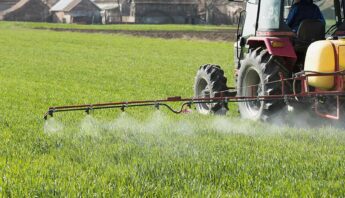After about 20 years of RoundUp use and 15 years of widespread planting of Monsanto's RoundUp-Ready GE crops, the efficacy of this herbicide is declining. Farmers are facing "superweeds" that can no longer be tamed by glyphosate, RoundUp's active ingredient. So now what?
Unfortunately, a new generation of crops engineered to resist mixtures of herbicide are waiting in the wings. As you've heard from my colleague Dr. Marcia Ishii-Eiteman, these new GE crops are completely the wrong response to this self-inflicted crisis. Meanwhile, researchers are raising new questions about the health and environmental effects of glyphosate itself.
Regardless of whether or not glyphosate is "safe" for human consumption, it's important to understand that this herbicide is part and parcel of a conventional agricultural system geared towards increasing, rather than decreasing, our dependence on chemical inputs — and thus increasing industry's profit.
Glyphosate is now the top herbicide used in the United States. The top herbicide-resistant crops in the country are RoundUp-Ready corn and soy. Due to its widespread use, researchers are now focusing more attention on the possibility of adverse effects on human health.
The GE-pesticide link
Part of my job here at PAN is fielding questions from the public and other nonprofit organizations on pesticides. I get a lot of questions about glyphosate. Anyone who asks me about glyphosate first gets an earful about the connection between glyphosate and genetically engineered (GE) crops.
Herbicide-resistant crop technology has led to a 527 million pound increase in herbicide use in the U.S. between 1996 and 2011. At the top of the list of herbicide-resistant crops are those engineered to be RoundUp resistant.
Not a great direction to be moving in terms of decreasing chemical inputs in agriculture, which is a growing concern. But it's a great direction if you're one of the companies selling pesticides and GE seeds.
With these dramatic increases in use, the frequency and level of human exposures to these herbicides have also gone up. As usage of glyphosate increases — for instance, as a wheat "dessicant" used at harvest-time to ensure that all of the crop is conveniently dry enough to harvest — glyphosate will continue to show up in everyday food items such as bread, and also in our surface water.
And it turns out that usage of herbicide-resistant technology isn't actually benefiting farmers much. A February 2014 report from USDA reviewed farmers' reasons for adopting GE crops. For four of the five crops, over 70% of the farmers surveyed cited increased yields as the primary reason. On the same page (please see p. 12), USDA says this:
Over the first 15 years of commercial use, GE seeds have not been shown to increase yield potentials of the varieties. In fact, the yields of herbicide-tolerant or insect-resistant seeds may be occasionally lower than the yields of conventional varieties if the varieties used… are not the highest yielding cultivars… (emphasis added).
So, there's a disconnect between USDA's information about yields and what farmers think. Industry's advertising appears to be more powerful than truth.
Any new news on health impacts?
Is it safe? Current risk assessment science indicates that glyphosate is not as toxic as some of the other pesticides that are still being used — at least not in comparison to some of the bigger and badder pesticides, such as chlorpyrifos, atrazine and DDT.
But it wasn't too long ago that we thought DDT was safe enough to spray in U.S. neighborhoods. You've probably seen some of those images. Given the lessons history has taught us with other chemicals, it seems most prudent to take a precautionary approach when considering our options. More chemical inputs in agriculture, or less? I vote for less.
Striking increases in the incidence of non-Hodgkin lymphoma cancer have occurred over the past 30 years. A 2014 systematic review and meta-analysis of epidemology studies broke down the relationship between non-Hodgkin lymphoma and occupational exposure to agricultural pesticides by group and by active ingredient.
Among the findings — a handful of those studies identified a positive association between glyphosate and B cell lymphoma (a type of non-Hodgkin lymphoma).
Given the information gaps in the chemical registration process (considerations of endocrine disruption in risk assessment, anyone?) and the fact that we know it can take years for science to catch up with pesticide effects, even pesticides like glyphosate that are described as "less toxic" should still raise big questions and be closely tracked.
A complex problem we can't ignore
There are other, more complicated truths about glyphosate. Last year, the New York Times published an article on soil health and the problems caused by widespread use of glyphosate.
According to a USDA scientist, glyphosate "seems to affect the rhizosphere, the ecology around the root zone, which in turn can affect plant health." Healthy soil depends on a complicated milieu of minerals, organic matter, bacteria and fungi. Upset that balance in the soil — which can't be "cooked" in a lab — and plant health declines.
Some of those truths are not so complicated. For instance, the rise of glyphosate-resistant "superweeds" is causing a problem in areas where those weeds are taking over agricultural land. The Texas Department of Agriculture recently requested a permit from EPA to "treat up to 3,000,000 acres of cotton to control glyphosate-resistant Palmer amaranth." Superweeds are causing problems in places other than Texas, as well.
Use more glyphosate, get glyphosate-resistant weeds. Use other pesticides to get rid of those resistant weeds, "stack" herbicide-resistant traits in GE crops and use more pesticides during the growing season. And so on, and so on…
A recent op-ed in the Des Moines Register described the problems created by GE technology as "GMO chickens coming home to roost." For some of the farmers in the New York Times article, the trick was to no longer grow GE crops. And maybe we need to invest in some other solutions… because this pesticide thing doesn't seem to be working out so well.








